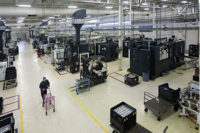Adrianus Pijper, in the South African Journal of Science, called the microscope “man’s noblest, supreme, and most far-reaching tool,” according to the Microscopy Society of America. And this was in 1939, before advancements such as electron microscopes or 3-D technology became available. “In microscopy, as with everything else, things get smaller and we magnify greater,” says Jeffrey McGinn, president and director of instrument sales at McCrone Microscopes & Accessories. Today, these instruments can help quality technicians in industries from medical to aerospace to automotive, and the market now includes the growing area of 3-D technology.
“There are a lot of people that don’t even know that microscopes can image in three dimensions,” says Matt Novak, manager, applications development, data storage optical products at Bruker Nano Surfaces Division.
But as applications require more functionality, 3-D microscopes continue to be in demand.
Julia Des Chenes, senior technical marketing specialist, micro analysis group at Keyence Corp., says that 3-D microscopes have a certain allure. “As soon as people see it, they usually want it,” she says. But that doesn’t mean they necessarily can buy one. It depends if their application justifies the purchase.
The Need for 3-D
The 3-D technology allows for measuring various features, and examining the profile, height and volume of a sample. And being able to see something in another dimension is often an advantage. It allows them to “get the full story for their part,” Des Chenes says.
Although the 3-D technology may be tempting, it is important to see if it is necessary with your application. “Every client of ours is like a research project,” says McGinn. “Microscopy can go in so many different directions. When a customer approaches us, the initial questions we ask are: What is the sample type? What are you looking to achieve in that sample?”
For example, if a customer is looking to do contamination ID, they could consider what type of contamination they expect to find, whether it is a metal flake or a mosquito. Then he can suggest options to meet their needs. And the process usually has some surprises: customers often say that they didn’t know that digital microscopy could do that. “It just blows them away,” McGinn says. “They say, ‘Wow, I had no idea I could see something like that.’ They didn’t realize that microscopes can do this much.”
And in terms of 3-D applications, this can be particularly impressive. Three-dimensional images can be used in inspection in quality departments, providing surface analysis, and allowing for a 3-D visual to show colleagues, something that is much more compelling and useful than a simple 2-D image, says Georg Schlaffer, product manager industry division at Leica Microsystems AG. But, he says that there are still misperceptions on what the technology can do, and customers may not realize the limitations.
Although there are limits, the field continues to advance. Customers want to look at larger fields of view, and with a smaller lateral resolution, says Novak. “They are looking at features smaller than 300 nanometers, trying to understand structures that are smaller than you would normally look at with 3-D.”
With manual microscopes, users change the focus by turning with their fingers. But, McGinn says, “In this 3-D digital microscopy age, they can punch those parameters into software and it’s exact.”
Applications
Though microscopes have been used in production control for decades, Novak says they are spreading into other applications, and growing in areas such as automotive. Manufacturers want to check the roughness of clutch disks or friction plates.
With the pressure to save money and material, Novak says that customers are looking for ways to reduce production costs. If customers are making 5,000 automotive shafts a day, they want to be sure the process is running smoothly. If there are flaws on a part, it helps to know early on. Consider a wire harness with a surface flaw.
“If you could just measure that surface where the roughness was created, with a tool, and check if it is really where it needs to be, then you don’t waste the time and energy to make those other steps,” Novak says. “You catch the problem at step 5 instead of 45.”
But just because the microscope and software have advanced far beyond the original use, it still doesn’t make the quality technician’s job easy. It still requires analysis and interpretation of results, Novak says. Training may be required both to operate the instrument and understand how to analyze the data from it.
Still, 3-D technology continues to be a growing area, as more companies realize they may not need 3-D capabilities now, but they might need something more advanced in the future.
“If people are investing in new lab equipment, there’s a tendency to want the newest and the best,” says Des Chenes, “and that’s going to be 3-D, hands down.”










